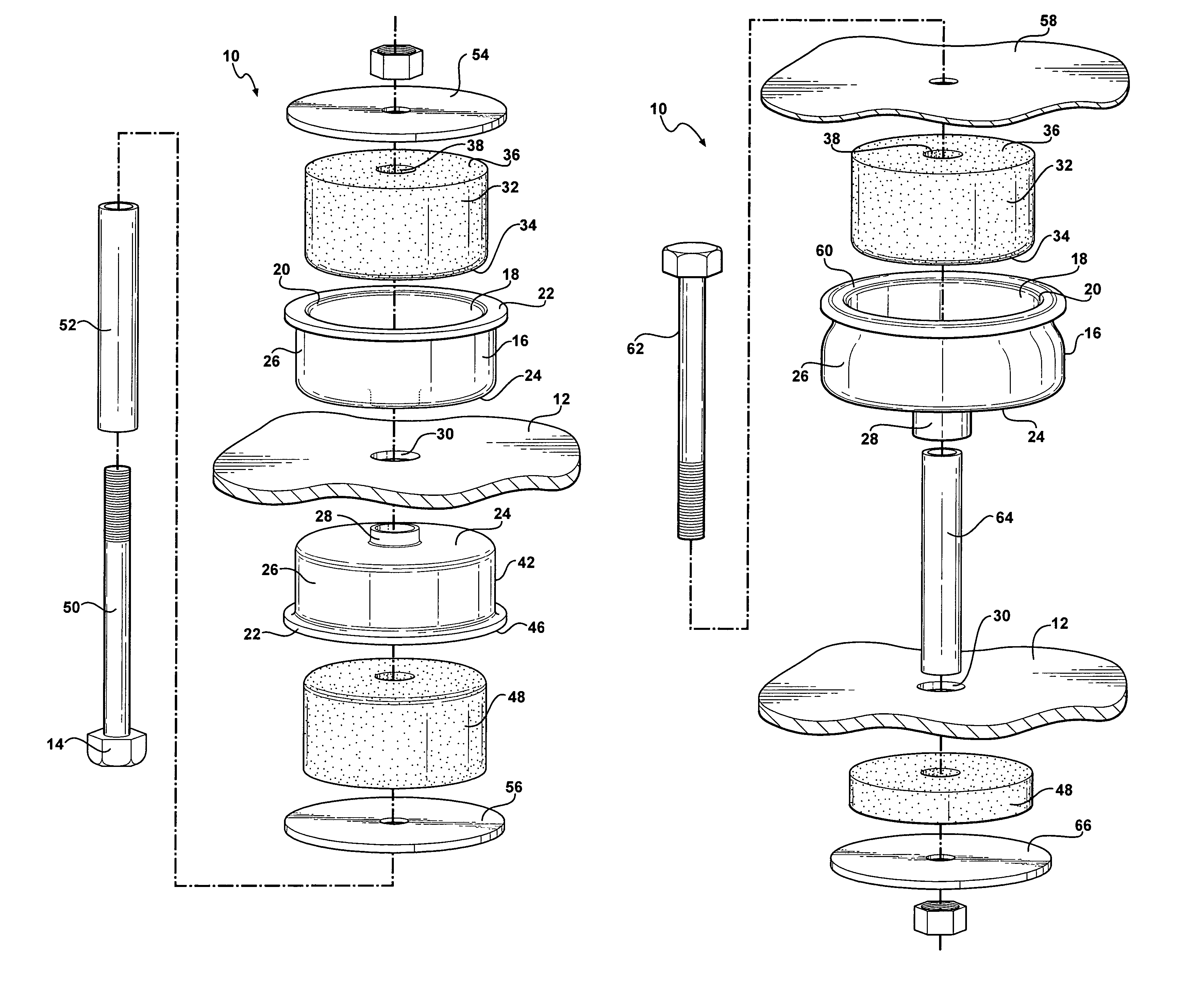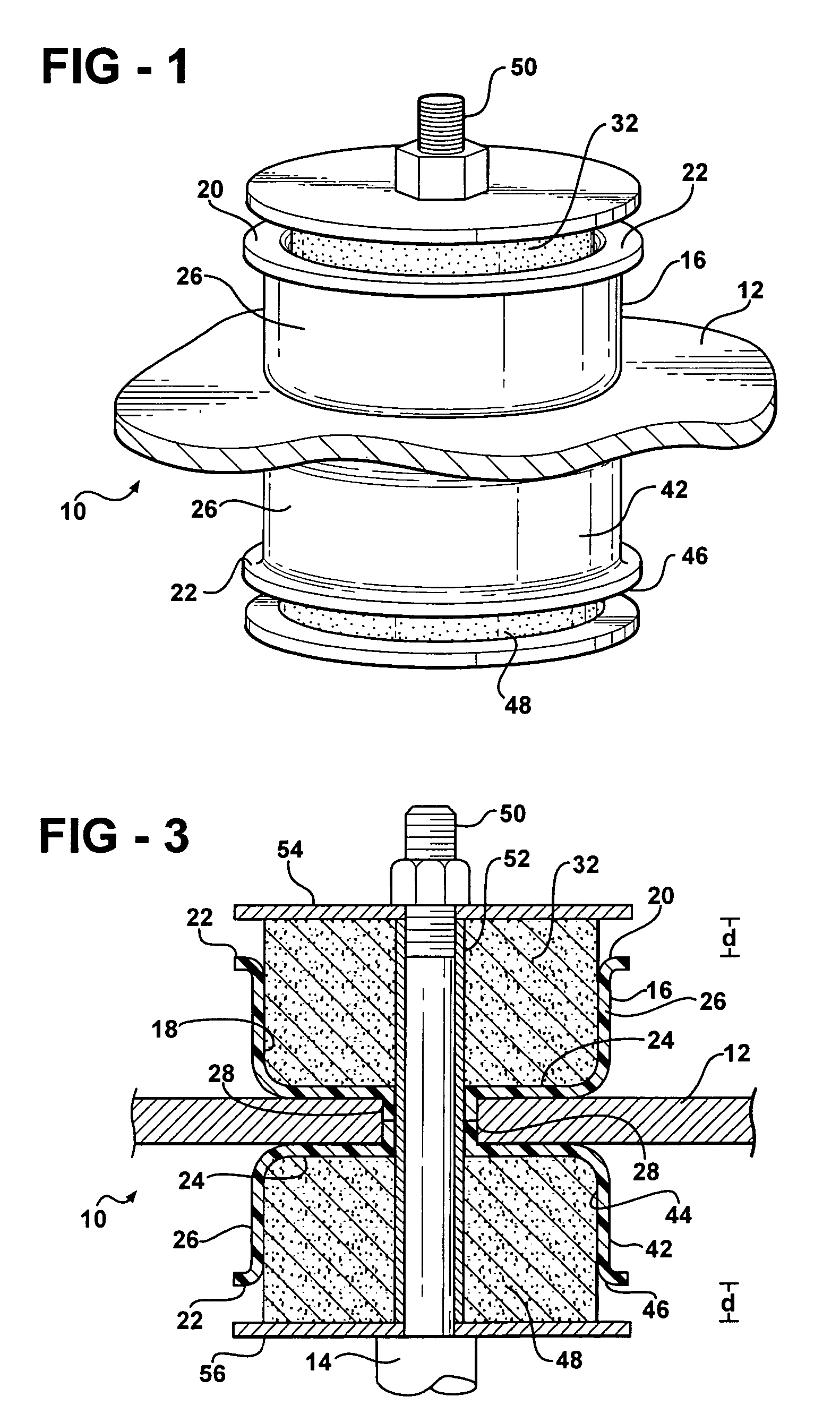Mount assembly
a technology of mounting brackets and mounting brackets, which is applied in the direction of roofs, machine supports, other domestic objects, etc., can solve the problems of inability to control the nature and location of the transition from soft to hard spring rates, the height of the mounting bracket is not easily adjustable, and the maximum displacement of the mounting bracket is sometimes still too large. , to achieve the effect of low maximum displacement, easy tunable or customizable, and reasonable heigh
- Summary
- Abstract
- Description
- Claims
- Application Information
AI Technical Summary
Benefits of technology
Problems solved by technology
Method used
Image
Examples
first embodiment
[0032]Similarly, the insulator 32 is further defined as a first insulator 32 and the first embodiment also includes a second insulator 48. The second insulator 48 is disposed within the second inner cavity 44 of the second carrier 42 and extends beyond the second peripheral outer rim 46 of the second carrier 42 in a similar fashion as the first insulator 32 within the first carrier 16.
[0033]The second carrier 42 is formed of a polyurethane elastomer having a third modulus of elasticity with the material properties in the same range as the first carrier 16. Preferably, the second carrier 42 is also formed of a homogenous polyurethane elastomer having a substantially uniform thickness. The second insulator 48 is formed of a microcellular polyurethane having a fourth modulus of elasticity that is less than the third modulus of elasticity of the second carrier 42. The first and third modulus of elasticity are substantially identical. Further, the second and fourth modulus of elasticity ...
second embodiment
[0039]The mount assembly 10 of this second embodiment also includes a carrier 16 preferably having a substantially cup shaped configuration defining an inner cavity 18 and a peripheral outer rim 20. Even more preferably, the peripheral outer rim 20 of the carrier 16 is continuous and substantially circular to form a substantially circular cavity 18 within the carrier 16. In this embodiment, however, the peripheral outer rim 20 of the carrier 16 preferably includes a curled distal end 60 curling outwardly away from the cavity 18. The cup shaped carrier 16 includes a substantially flat bottom 24 and a substantially upstanding wall 26 extending between the peripheral outer rim 20 and the flat bottom 24 to further define the cavity 18 within the carrier 16. The flat bottom 24 of the carrier 16 defines an opening and the carrier 16 further includes a second wall 28 surrounding the opening and extending in a direction opposite to the upstanding wall 26.
[0040]The carrier 16 is adapted to b...
third embodiment
[0057]Another advantage of using the elastomeric polyurethane, such as thermoplastic or thermoset polyurethane, and microcellular polyurethane is that these materials are readily bondable using urethane glues, as is well known in the art. As such, the microcellular polyurethane insulator 32 could be bonded within the inner cavity 18 of the elastomeric polyurethane carrier 16. FIG. 9A illustrates an enlarged sectional view of the insulator 32 and carrier 16 of this third embodiment, which shows a layer of urethane glue 40 bonding the insulator 32 to the carrier 16. This ability to bond allows for an integrated composite mount assembly 10 without any additional fastening means.
[0058]As shown in FIG. 9, the strike plate 68 can move to abut the insulator 32 and then compress the insulator 32 through a distance (d) relative to the vehicle body 58, which isolates the vehicle body 58 from the strike plate 68. As the strike plate 68 continues to compress the insulator 32 beyond the distance...
PUM
 Login to View More
Login to View More Abstract
Description
Claims
Application Information
 Login to View More
Login to View More - R&D
- Intellectual Property
- Life Sciences
- Materials
- Tech Scout
- Unparalleled Data Quality
- Higher Quality Content
- 60% Fewer Hallucinations
Browse by: Latest US Patents, China's latest patents, Technical Efficacy Thesaurus, Application Domain, Technology Topic, Popular Technical Reports.
© 2025 PatSnap. All rights reserved.Legal|Privacy policy|Modern Slavery Act Transparency Statement|Sitemap|About US| Contact US: help@patsnap.com



